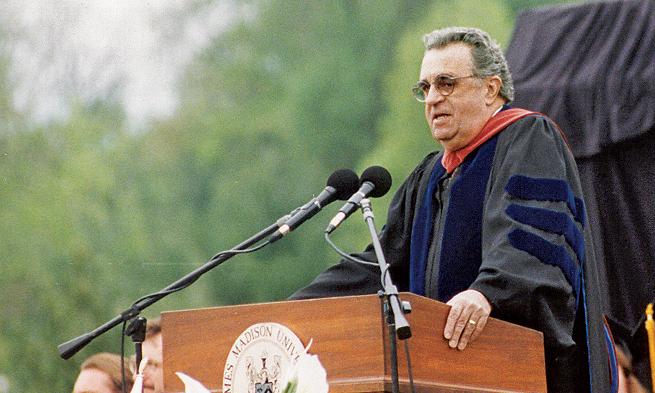Ronald E. Carrier
Being the Change
"Uncle Ron" takes Madison to a university and beyond
Excerpts from Madison Century, a commemorative book by Martha Graham
Condensed from the article in Spring 2008 Madison
In 1970, Madison College was the largest teachers college in the state, and although it was fully coeducational, it was still thought of as a women's college. It was a perception that would soon change. When Ronald E. Carrier came to Harrisonburg as the college's fourth president, he brought two fundamental beliefs to the Madison campus in 1971—the promise of education and confidence in students—two beliefs that, over the next 27 years, would shape the institution into a respected regional university.
All about the students
Ron Carrier believed students should be the focus of the school. ...Building on a long tradition of women's sports and a successful men's soccer team, he ramped up athletics programs, starting with track, and then football. In what might be considered a brazen attempt to recruit men, the football program—the one collegiate sport without a female counterpart—yelled a welcome to male applicants that many heard loud and clear. Applications began to rise. Enrollment of men began to rise. ...
Academics for a new university
Although growth and athletics were the most visible changes during the early years of the Carrier administration, they were not the most substantive. Early in the Carrier years, academic divisions were realigned into schools, foreshadowing the colleges on which a university would grow. ...
President Carrier had a fundamental and personal understanding of the opportunities higher education provided. As one of 11 children growing up in Bluff City, Tenn., he had long looked at education as the means to lifelong opportunity. ...
Many students spent evenings at Hillcrest discussing ideas with the young president over Reuben sandwiches. His accessibility and camaraderie with students led students to nickname him "Uncle Ron."
When Carrier assumed the presidency in 1971, the college awarded only three graduate degrees: Masters of Arts and Science in Education and a Master of Science in Biology. During the Carrier administration, the graduate school grew exponentially to include graduate programs in art, music, and special education. In 1994, JMU introduced the first doctoral program, a Doctor of Psychology degree.
Despite the important growth in graduate programs, a fundamental emphasis on undergraduate education remained and, aligned with graduate programs, led to a new emphasis on undergraduate research opportunities for students....
In 1977, by decree of the Virginia General Assembly, Madison College became James Madison University. Students, alumni and faculty all favored the name change but, interestingly, those most in favor of the change were the oldest alumni. They understood that the State Normal School, Harrisonburg Teachers College and Madison College had become a university. ...
The faculty, emboldened now as members of a university, accomplished exciting things, all while teaching students imbued with the same enthusiasm. Throughout the Carrier years, teaching had been a priority. Faculty members led in their fields. ...
Exploding the 'box'
Carrier's clearest eye was always focused on the future. While some presidents might have rested on the major accomplishments of a successful 20-year career, Carrier didn't. He knew he had to get the university ready for the future that was coming at him fast. "My biggest fear is that the future will get here before I'm ready," he once said. Following a leave of absence in 1986 to serve as president of the Center for Innovative Technology in Northern Virginia, Carrier returned to campus with a new vision of the university's future.
Heeding the state's 1988 call for new and innovative approaches to education, Carrier proposed a new college to meet the educational needs of the future, particularly as they pertained to technology, a phenomenon evolving at warp speed. In January 1992, the state sanctioned a new college that would become JMU's new College of Integrated Science and Technology. ...
When he retired in 1998, President Ron Carrier left a campus and a school quite different from the one he had first led in 1971. In addition to an enrollment of more than 14,000, which included minorities and international students, the campus had 40 new buildings, 100 more acres, a new college with a new campus on the other side of the interstate, a doctoral program and a reputation, according to U.S. News & World Report, as the finest public master's level university in the South.
